Tiempos verbales en inglés
Una parte importante del aprendizaje de un idioma es poder usar diferentes tiempos verbales. En inglés, hay 13 tiempos verbales, y todos se utilizan diariamente por hablantes nativos. Como estudiante, puedes pensar que es mucho para aprender, pero no te preocupes, en Wall Street English estudias cada tiempo verbal de uno en uno durante todo el curso. Primero escuchas el tiempo usado en un diálogo, luego entiendes cuándo y cómo se usa, y luego lo más importante, practicas su uso.
THE PRESENT (EL PRESENTE)
The Present Simple (El Presente Simple)
se usa para describir
- hechos permanentes
- hábitos
- rutinas
- opiniones
El Presente Simple se forma usando la base del infinitivo.
Mira los siguientes ejemplos para formar el verbo “To work”:
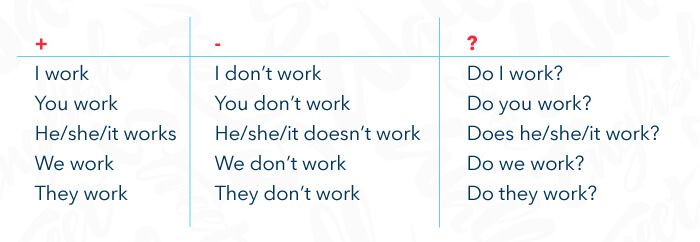
Ejemplos:
The sun rises in the east.
We do the shopping on Saturdays.
Do you often go out at the weekend?
I get up at 7 am every day.
He loves Sushi.
They don’t like football.
The Present Continuous (El Presente Continuo)
se utiliza para describir:
- acciones en curso
- planes fijos en el futuro.
El Presente Continuo está formado por el verbo To Be + Gerundio (ing)
Mira los siguientes ejemplos:
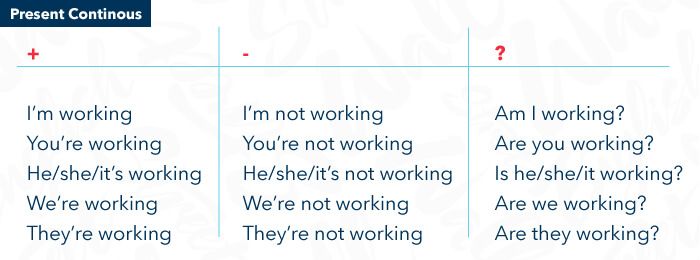
Ejemplos:
Kim is studying.
It’s raining.
Are they waiting for the bus?
We’re meeting Paul at 2pm.
You’re going to the dentist tomorrow morning, aren’t you?
THE PAST (EL PASADO)
The Past Simple (El Pasado Simple)
se utiliza para describir:
- una acción que comenzó en el pasado y terminó en el pasado, generalmente en un momento específico, en el pasado.
El Pasado Simple para verbos regulares está formado por el verbo base + ed.
Mira los siguientes ejemplos:

Ejemplos:
I cried at the cinema last week.
We lived in Indonesia from 1984 to 1996.
Did you enjoy the party last Tuesday?
They laughed at the joke.
Mozart died in 1791.
The Past Continuous (El Pasado Continuo)
se utiliza para describir:
- una acción en progreso en un momento específico en el pasado
- una acción en progreso cuando sucedió otra acción
El Pasado Continuo está formado por Was / Were + Gerundio (forma ing).
Mira los siguientes ejemplos:
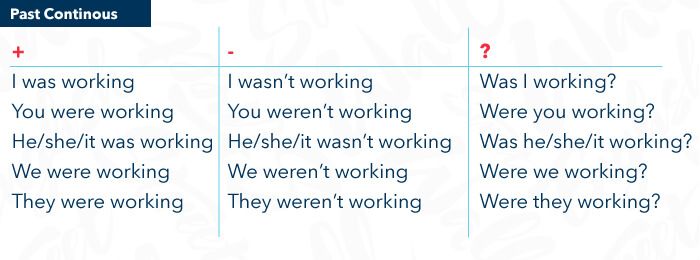
Ejemplos:
What were you doing at 8 pm last night?
I was having dinner.
He was having a shower when the phone rang.
The staff were having a coffee when the boss came in.
The Present Perfect (El Presente Perfecto)
se utiliza para describir:
- situaciones a largo plazo que comenzaron en el pasado y continúan en el presente
- acciones terminadas que sucedieron en un tiempo inacabado
- acciones terminadas que sucedieron en un tiempo indefinido
El Presente Perfecto está formado por el verbo Tener + el Participio Pasado.
Mira los siguientes ejemplos:
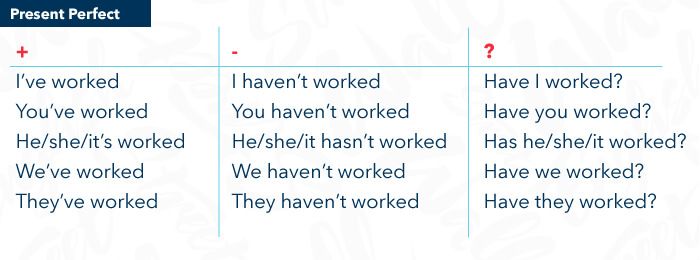
Ejemplos:
They’ve lived in Paris since 1996. (They moved to Paris in 1996 and still live there.)
He’s been the boss for twenty years.
She’s visited Shanghai twice this year.
We haven’t seen Camille today.
Have you finished your project yet?
I’ve been to Paris several times
The Present Perfect Continuous (El Presente Perfecto Continuo)
se utiliza para describir:
- una acción temporal que comenzó en un momento específico en el pasado y continúa en el presente
- una acción recurrente que comenzó a ocurrir en el pasado y continúa en el presente
- La duración de una acción o el efecto que tiene.
El Presente Perfecto Continuo está formado por el verbo Tener + Been + Gerundio (forma ing).
Mira los siguientes ejemplos:

Ejemplos:
You’ve been studying for three hours. You need a break!
He’s been phoning the office all day!
I’ve been waiting for 2 hours and I’m fed up! Where have you been?
They’ve been having problems with this road for years.
How long has this been going on?
The Past Perfect (El Pasado Perfecto)
se utiliza para describir:
- Una acción que terminó antes de otra acción pasada.
El pasado perfecto está formado por Had + el participio pasado.
Mira los siguientes ejemplos:
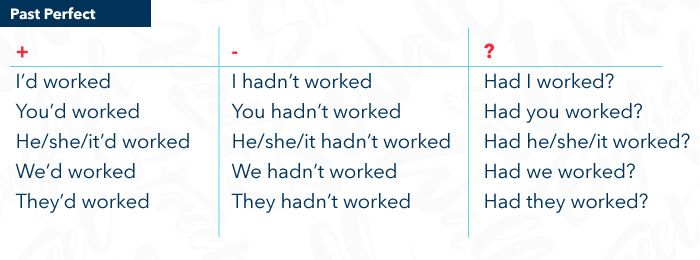
Ejemplos:
When we got home, Hassan had already gone to bed.
The film had just started when we turned on the television.
I didn’t have dinner with my friends because I’d already had dinner at home.
Had the meeting started when you arrived?
The Past Perfect Continuous (El Pasado Perfecto Continuo)
se utiliza para describir:
- Una acción progresiva que terminó antes de otra acción pasada.
El Pasado Perfecto Continuo está formado por Had + Been + Gerund (forma ing).
Mira los siguientes ejemplos:

Ejemplos:
I’d been waiting for 40 minutes when the train finally came.
They’d been doing research for years when the found the answer.
She hadn’t been working long at the firm when they promoted her.
Had you been driving for long when you had a break?
THE FUTURE (EL FUTURO)
Will
Se utiliza para describir:
- predicciones
- promesas
- Decisiones tomadas en el momento de hablar.
El futuro con “will” está formado por Will + la forma Base del infinitivo.
Mira los siguientes ejemplos:
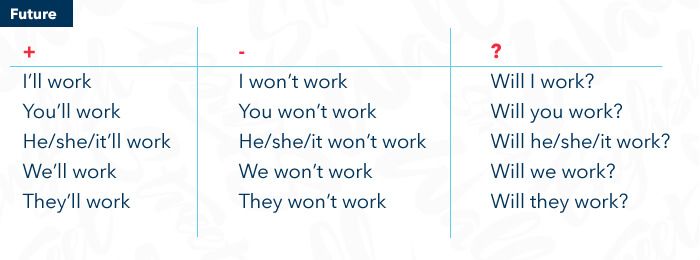
Ejemplos:
Hannah thinks there will be a lot of people at the concert.
I’ll phone you later.
They’ll be at the station now.
I’ll have a glass of water, please.
We’ll see you soon.
Be Going To
Se utiliza para describir:
- intenciones
- predicciones basadas en evidencia presente
El futuro con “Be Going To” está formado por el verbo “To Be” + Going To + Infinitivo.
Mira los siguientes ejemplos:

Ejemplos:
I am going to work tomorrow.
We’re going to have a pizza for dinner.
Are they going to make a decision today?
Look at those black clouds. It’s going to rain soon.
There’s going to be a big problem with plastic waste in the future.
The Future Continuous (El Futuro Continuo)
se utiliza para describir:
- una acción que está en progreso en un momento particular en el futuro
- una solicitud educada y formal de información
El futuro continuo está formado por Will + Be + Gerundio (forma ing).
Mira los siguientes ejemplos:
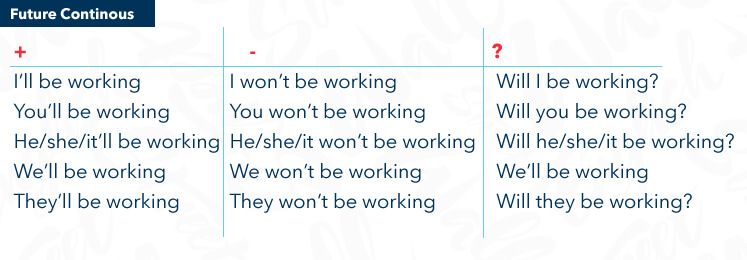
Ejemplos:
This time next week I’ll be lying on the beach!
Let’s meet at the station at 3 pm. I’ll be standing outside the café.
She’ll still be sleeping at 11 am on Sunday so don’t phone her until lunchtime.
Will you be staying at the hotel for dinner Sir?
The Future Perfect (El Futuro Perfecto)
se utiliza para describir:
- una acción completada antes de un tiempo futuro
El Futuro Perfecto está formado por Will Have + el participio pasado.
Mira los siguientes ejemplos:

Ejemplos:
She’ll have finished the report by 5 pm.
The kids will have already eaten by the time I get home.
I won’t have made my presentation by the end of today’s session.
Will you have arrived in the office by lunchtime?
The Future Perfect Continuous (El Futuro Perfecto Continuo)
Se utiliza para describir:
- Una acción progresiva antes de un tiempo futuro.
El Futuro Perfecto Continúo está formado por Will Have Been + Gerundio (forma ing).
Mira los siguientes ejemplos:

Ejemplos:
We’ll have been working on this presentation for two weeks by Friday.
By the time dinner is ready, Mum will have been cooking for six hours!
She’ll have been studying for hours by the time we get home.
They won’t have been waiting long, don’t worry.
Descubre tus conocimientos sobre los diferentes tiempos verbales del inglés con este breve y divertido ejercicio.
¿Sabes qué es el participio pasado en inglés y para qué se usa? Siga leyendo para obtener más información sobre esta parte importante de la gramática inglesa.
Cuando damos una referencia temporal hay varias palabras que utilizamos, como at, on, in, y también for y since. Sigue leyendo para saber cuándo utilizar cada una de ellas.